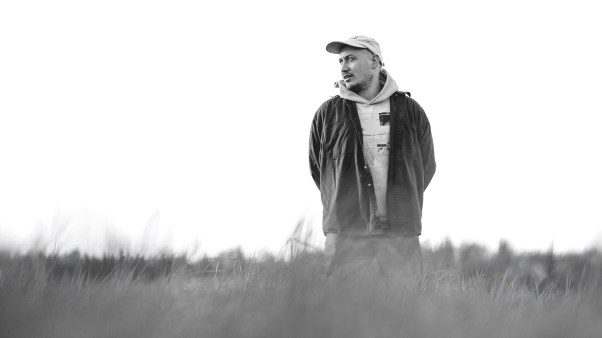I have a friend, an artist, who says the first thing she notices about a person is the colored splotch on the inner part of the eye socket where it curves upward to become a part of the nose, whether it is blue or purple or maybe slightly green. When she told me this, it startled me, and I was glad I was wearing glasses that hid my own little spot of color until I could go home and check it out for myself. If she had said that the first thing she noticed was the firmness of a person’s handshake or the warmth of his smile or any of a dozen other characteristics by which we are admonished to judge people, I would not have felt self-conscious. But the inside of one’s eye socket? That suddenly seemed a naked, vulnerable spot.
Charles Williams, in Descent of the Dove (Oxford, 1939, pp. 57–62), says people have sought God in two seemingly contradictory ways: through the senses (that is, by apprehending his creation) and through the suppression of the senses, what is called the via negativa. “The Way of Affirmation was to develop great art and romantic love and marriage and philosophy and social justice,” he says; “the Way of Rejection was to break out continually in the profound mystical documents of the soul, the records of the great psychological masters of Christendom.”
But the way of rejection is one that few have followed. Williams cites an ancient canon, dating from the second or third century, to illustrate the church’s official attitude toward the material world: “If any bishop or priest or deacon, or any cleric whatsoever, shall refrain from marriage and from meat and from wine, not for the sake of discipline but with contempt, and, forgetful that all things are very good and that God made man male and female, blasphemously inveighs against the creation, let him either be corrected or deposed and turned out of the Church. And so with a layman.” (Italics mine.)
Now in no way would I want to undermine the validity of the via negativa. It has had little enough honor, especially in the Protestant tradition, where deprivation of the senses is usually “for your own good” rather than for God’s good. Indeed, how any good could derive from fasting, retreat, silence, or celibacy (despite our Lord’s practice of them all) has often escaped our notice as we clucked our tongues over the Roman monastic tradition. At least part of the success of the recent rapproachement between Protestants and Catholics can be attributed to the changes by which nuns dress like “normal people” and priests insist on matrimonial rights.
However, our defense of the former way, access to God through the full use of our senses, has of late been truncated and confused. The reasons are numerous and tiresome. For a start, most of the population is surrounded not by primary creation—the things that only God can make, such as trees—but by secondary or even tertiary creation—the things that God’s creatures can make or the things that God’s creatures’ creations, i.e., machines, can make. And those secondary and tertiary products are often shoddy enough to merit only the cursory attention they get.
So that when my friend speaks of the subtle colors on human faces, it strikes us as extraordinary, a little odd, even faintly amusing, but not of the earth-shaking importance it truly is. For how are we to give thanks for something we’ve never noticed? How shall we praise God for the world we’ve not paid proper attention to? Our practice of pigeonholing our praise into broad categories—family, friends, country, health, and the like—reminds me of the all-purpose five-second prayer I devised as a child for use on cold nights: “God bless everybody in the world. Amen.” When we pray in terms of everybody-in-the-world, we imagine ourselves to be dealing with a divine, omniscient bureaucracy. But God doesn’t love everybody-in-the-world. He loves each of us singly, knowing the hairs of our heads and the shadows of our eye sockets.
One of the chief champions of this way of the senses in the Protestant tradition is, surprisingly, Jonathan Edwards, whose reputation as a dour example of asceticism is due to his overly anthologized and journalistically interpreted sermon, “Sinners in the Hands of an Angry God.” On the contrary, Edwards’s early attention was absorbed by the natural sciences, the careful observation of spiders being his specialty. But natural science was not a mere sideline to his theological thought. His scrutiny of creation provided the full heart out of which he wrote his doctrine of creation, with which physics is only now catching up. “God not only created all things, and gave them being at first, but continually upholds them in being,” he says. “It will certainly follow from these things, that God’s preserving created things in being is perfectly equivalent to a continued creation, or to his creating those things out of nothing at each moment of their existence” (Works, II, 487 ff.).
Think of it. With each breath we take, God is again pumping into our lungs his exhalation of the breath of life, just as he did for Adam. If he withdrew his breath from the bubble of our world, it would instantly collapse. We are not a clock, once wound, running down. Developing this sense of continuous creation pulls the mask from our eyes, enables us to see creation hanging on God’s breath, dependent, contingent. And the precariousness makes it all the more precious.
The world’s existence hangs on God’s continuing to pay attention to it, and to be properly thankful we in turn must pay rapt attention to his crafting. But there are dangers. In Pilgrim at Tinker Creek, Annie Dillard tells of her meticulous search of her surroundings in rural Virginia, from the single-cell algae in her pond to the view of Alpha Centauri from her backyard. Sometimes the evidence is devastating: nature is wasteful, extravagant, cruel, predatory. Never does the evidence point to chance, mere random agitation of atoms; and sometimes it points to the universe as the creation of a madman, a sadist. Yet it is beauty itself that is ultimately the answer to her questions, the fact that we desire and seek out beauty, that we separate the beautiful from the broken in creation. “No, I’ve gone through this a million times, beauty is not a hoax,” she testifies. “Beauty is real. I would never deny it. The appalling thing is that I forget it” (Bantam, 1974, p. 273). It takes attention, rapt attention, to keep that reality before us. But our attention span is limited. Is this not perhaps the meaning of sleep, that dark bed of mystery in which our consciousness must rest in order to be restored to its task of thanksgiving?
When Jesus instructed us to “consider” the lilies of the field and the fowls of the air, he wasn’t making some moralistic point, as in the dreadful fable of the ant and the grasshopper that was used to goad earlier generations into productive activity. The point of considering lilies is just the opposite: they are lazy lilies, occupying space amid the common field grasses for no reason other than that it pleases God. Can we appreciate God’s creative prodigality? The idea of trillions of stars and cells offends our sense of proportion, especially as they keep exploding and dying. How can we praise such a wastrel, we who now are sweating out every barrel of oil and ton of coal? It’s all very well for him to frivol about with wildflowers, but what about us—what shall we eat, what shall we drink, where shall we find fuel for the morrow?
Yet our business is not to be anxious about these matters but to praise God, to exult in him. And the most accessible way for most of us is through God’s creation. What we call nature—flowers and trees and birds and bees, scorpions and hail and sharks—this is primary creation and reveals the “nature” of its Creator, the way he is. We know what steadfastness is because we see eons of predictability in the physical world. We know what surprise is because of sudden storms.
Andrew Wyeth once told an interviewer, “I love to study the many things that grow below the corn stalks and bring them back into the studio to study the color. If one could only catch that true color of nature—the very thought of it drives me mad.” That is considering the lilies of the field. And it effectively drives out utilitarian anxiety.
Or take for an example Rachel Peden, a woman of uncommon considering power, who in her book Speak to the Earth describes the exploration of a hound’s-tongue seed: “The dime-sized seed pod is enclosed by five sepals and marked off into four parts with a single spike rising at the center. I pinched open one yellow-green, burry section of this fruitlet and saw the watery unripe seed inside. The brown stalk gave out an uninviting smell, sometimes compared to mouse smell.… I like it because it is pretty and interesting and we were having a good time fishing when I first saw hound’s-tongue” (Knopf, 1974, p. 82). On God’s scale of knowledge, which weighs heavier: knowing the market value of Nielsen ratings or knowing that a broken stalk of hound’s-tongue smells mouselike?
Unfortunately, there is unrelenting pressure not to pay very close attention to creation but instead to consume oneself with anxiety about survival. A bizarre example of such pressure comes from a recent book called Language and Woman’s Place: the author cautions women not to make fine color distinctions—not to speak of mauve and lavender, for instance, because powerful people in our society lump them all together as purple. (While Andrew Wyeth meticulously studies the various shades of snow.)
The demonic line of reasoning runs like this: If human senses, often employed to subvert the spirit, can also be a primary access to God in this world, then humanity must be harassed into not using them. “You see one mountain, you’ve seen them all,” a friend, since demitted from the ministry, said to me. I felt the cold wind of blasphemy on my face. Really seeing a mountain would take a lifetime, I protested silently. Or longer than that if we are to believe Dante, who pictured purgatory as mountainshaped.
When Thornton Wilder wrote Our Town, his notion of purgatory was attention paid too late, misplaced in an afterlife of awareness devoid of action. When Emily dies in childbirth and joins the dead in the hillside cemetery, she wants to go back and observe just one day of her short life. “Choose the least important day in your life,” the dead advise her. “It will be important enough.” Emily’s final soliloquies echo the lament of the psalmist who dreads to go down into the pit where there is no longer the possibility of praise. “I love you all—everything,” she cries out to the world that can no longer hear her. “I can’t look at everything hard enough.… Wait! One more look. Good-by, Good-by world. Good-by, Grover’s Comers … Mama and Papa. Good-by to clock’s ticking … and Mama’s sunflowers. And food and coffee. And new-ironed dresses and hot baths … and sleeping and waking up. Oh, earth, you’re too wonderful for anybody to realize you. Do any human beings ever realize life while they live it?—every, every minute?” (Treasury of the Theatre, ed. John Gasser, Simon and Schuster, 1960, p. 948).
And the Stage Manager replies: “No. The saints and poets, maybe—they do some.”
My friend the artist, the observer of eye sockets, consented to give me drawing lessons. “It’s simple eye-hand coordination,” she insists impatiently. Although I learned to excel in only two areas, long-haired sleeping dogs and aspen bark, I learned concomitantly to give thanks for a great many aspects of creation I had never known existed before. The great gaping holes in my universe were suddenly filled with such intricate detail that my eyes began to grow bulgy from looking. They felt too small to admit all the things there suddenly were to see: where the whiskers grow on a cat’s nose and how exceptionally long they are, the receding ridges within a sandstone cave, the rounding slope of my daughter’s upper lip.
“Divinity is not playful,” Annie Dillard warns us. “The universe was not made in jest but in solemn incomprehensible earnest. By a power that is unfathomably secret, and holy, and fleet. There is nothing to be done about it, but ignore it or see” (p. 278). Sometimes when I have been focusing overlong on the miniscule world of leafhoppers hatched in mold still damp from snowmelt, or when I feel physically assaulted by the bombardment of stimuli from a supposedly dead, silent winter day at my back door, I think it costs too much. The whole human race is not enough to search out each cunning device of its untiring creator. But attention is the price we must pay for awareness—without which there is no thanksgiving.
D. Bruce Lockerbie is chairman of the Fine Arts department at The Stony Brook School, Stony Brook, New York. This article is taken from his 1976 lectures on Christian Life and Thought, delivered at Conservative Baptist Theological Seminary in Denver, Colorado.










